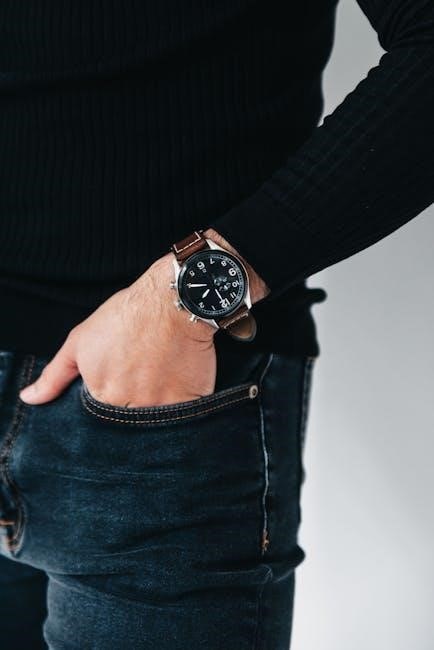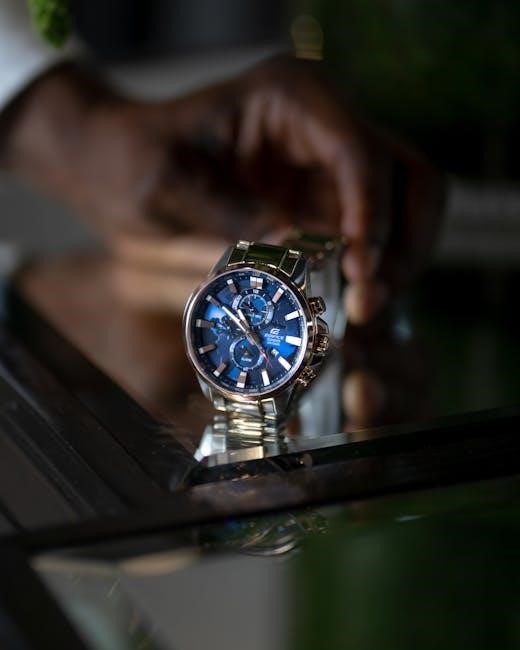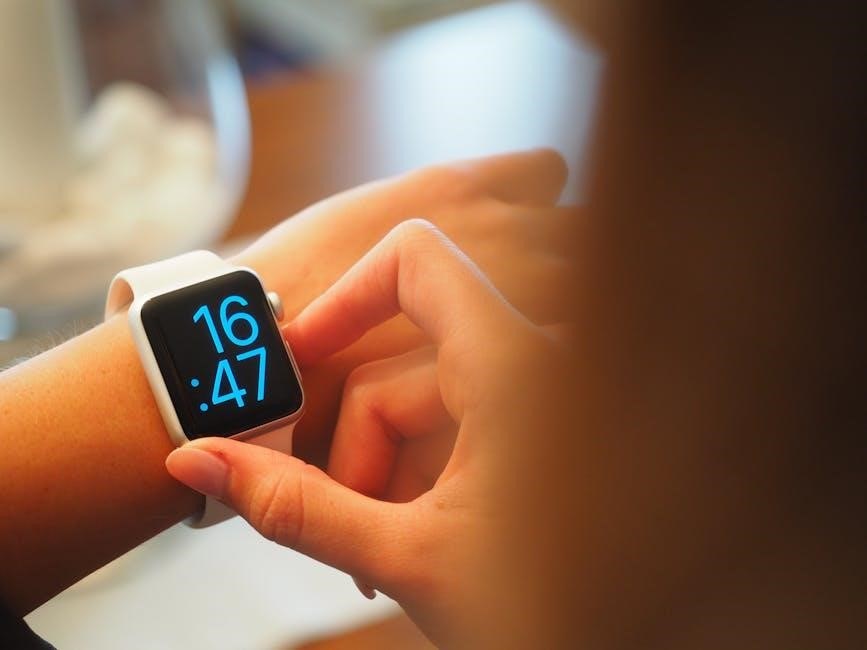Wristwatches are more than time-telling devices; they are statements of style, craftsmanship, and personal expression. This guide helps you navigate the world of wristwatches.
1.1 Importance of Choosing the Right Wristwatch
Choosing the right wristwatch is essential as it reflects your personal style, serves functional purposes, and can act as a status symbol. With countless options available, selecting a watch that aligns with your lifestyle, wardrobe, and preferences is crucial. A wristwatch is more than a time-telling device; it’s a statement of artistry and craftsmanship. Whether for daily wear, formal events, or sports activities, the right watch enhances your overall appearance and functionality. This guide helps you navigate the complexities of selecting a watch that perfectly complements your needs and tastes, ensuring a lasting and satisfying ownership experience.
1.2 Brief History of Wrist Watches
Wristwatches evolved from pocket watches in the late 19th century, becoming practical with leather straps during World War I for military use. Their popularity soared in the 20th century with advancements like quartz movements. The 1980s saw the rise of digital and smartwatches, blending technology with tradition. Today, wristwatches symbolize style, craftsmanship, and innovation, serving as both functional tools and fashion statements. Their rich history reflects human ingenuity and the relentless pursuit of precision, making them timeless companions in everyday life. This legacy continues to inspire modern designs, ensuring wristwatches remain indispensable accessories.

Types of Watches
Wristwatches come in various styles, catering to different preferences and purposes. Common types include:
- Dive Watches: Built for underwater activities.
- Pilot Watches: Designed for aviation needs.
- Dress Watches: Elegant for formal events.
- Smartwatches: Combining technology with timekeeping.
- Field Watches: Practical for outdoor adventures.
Each type offers unique features tailored to specific lifestyles or professions, ensuring there’s a watch for every individual’s needs and preferences.
2.1 Dive Watches
Dive watches are specifically designed for underwater activities, offering exceptional water resistance and durability. They typically feature unidirectional rotating bezels to track dive times, luminous dials for readability in low light, and robust materials like stainless steel or titanium. Many dive watches meet ISO 6425 standards, ensuring they can withstand extreme water pressure. Some models include additional features such as helium escape valves for deep-sea diving. These watches are perfect for scuba divers, snorkelers, and anyone seeking a sturdy, water-resistant timepiece. Their rugged design and functional features make them a popular choice for both underwater adventures and everyday wear.
2.2 Pilot Watches
Pilot watches are designed for aviation, offering functionality and durability for pilots. They typically feature large, legible dials with luminous hands and Arabic numerals for quick readability. Chronograph functions are common, allowing pilots to measure elapsed time, while some models include slide rules for calculations. Built for rugged use, pilot watches often have scratch-resistant crystals and robust materials like stainless steel or titanium. Many are equipped with anti-magnetic properties to ensure accuracy in environments with magnetic interference. These watches are not only practical tools for aviation but also stylish timepieces that appeal to enthusiasts of aviation history and precision engineering.
2;3 Dress Watches
Dress watches are elegant timepieces designed for formal occasions, embodying sophistication and refinement. They typically feature sleek, minimalist designs with slim profiles to fit under cuffs. These watches often use high-quality materials like precious metals, stainless steel, or ceramic, paired with leather straps for a classic look. Dress watches prioritize aesthetics over functionality, with simple dials and subtle details. They are ideal for complementing formal attire and making a stylish statement. Their timeless appeal ensures they remain a cornerstone of any discerning watch collection, blending seamlessly with both traditional and modern fashion.
2.4 Smartwatches
Smartwatches are modern, tech-driven timepieces that combine traditional watch functionality with advanced digital features. They often include heart rate monitors, fitness trackers, and app integration, catering to active lifestyles. These watches allow users to receive notifications, control music playback, and access various smartphone features directly from their wrist. While they may lack the mechanical allure of traditional watches, smartwatches offer unparalleled convenience and versatility. They are perfect for those who value innovation and practicality, blending seamlessly into modern life with their sleek, contemporary designs and user-friendly interfaces. This makes them a popular choice for everyday wear.
2.5 Field Watches
Field watches are practical timepieces designed for outdoor and military use, emphasizing durability and functionality. Originating from military needs, they feature clean, legible dials with illuminated hands for visibility in low light. Built with robust materials like stainless steel or titanium, these watches are designed to withstand rough conditions. Their simple, no-frills design makes them versatile for everyday wear. Often equipped with features like date displays and unidirectional rotating bezels, field watches are ideal for adventurers and professionals seeking reliability. They strike a balance between ruggedness and style, offering a timeless appeal for those who value practicality and simplicity.

Watch Movements
Watch movements are the mechanisms powering timepieces, available in mechanical, automatic, or quartz options. Each offers unique accuracy, maintenance, and craftsmanship, shaping the watch’s functionality and appeal.
3.1 Mechanical Movements
Mechanical movements are powered by a mainspring, requiring manual winding to store energy. These intricate mechanisms are prized for their craftsmanship and traditional horology. Unlike automatic or quartz watches, mechanical timepieces demand regular maintenance, including winding and servicing. While they may lack the precision of quartz movements, enthusiasts appreciate their mechanical beauty and the artistry involved in their creation. Mechanical watches often feature visible gears and springs, offering a glimpse into their inner workings. For collectors and purists, mechanical movements embody the heritage and soul of watchmaking, making them a cherished choice despite their higher upkeep requirements.
3.2 Automatic Movements
Automatic movements, also known as self-winding movements, combine the elegance of mechanical watches with the convenience of automatic winding. They harness the wearer’s motion to power the mainspring, eliminating the need for manual winding. A rotor oscillates within the watch, converting kinetic energy into stored power. This mechanism offers the beauty of mechanical craftsmanship while providing the practicality of a watch that winds itself. Automatic movements are ideal for those who appreciate the art of horology but prefer not to wind their watch daily. However, like mechanical watches, they require regular servicing to maintain accuracy and functionality over time.
3.3 Quartz Movements
Quartz movements are powered by a battery and utilize a quartz crystal that oscillates when an electric current is applied. This precise oscillation divides time into equal parts, making quartz watches highly accurate. They require minimal maintenance, with battery replacements typically needed every 1-2 years. Quartz movements are lightweight, durable, and resistant to shocks and temperature changes. They are ideal for everyday wear and are often more affordable than mechanical or automatic watches. With no need for manual winding, quartz watches offer convenience and reliability, making them a popular choice for casual and sporty timepieces.

Watch Materials
Watch materials vary in durability, aesthetics, and luxury appeal. Common options include stainless steel, titanium, ceramic, and precious metals, each offering unique benefits for different lifestyles.
4.1 Stainless Steel
Stainless steel is one of the most popular materials for wristwatches due to its exceptional durability and resistance to corrosion. It is highly versatile, suitable for both casual and formal settings, making it a versatile choice for everyday wear.
Stainless steel watches are known for their sleek appearance and ability to withstand scratches and fading. They are also hypoallergenic, making them ideal for those with sensitive skin. This material strikes a perfect balance between style and practicality, ensuring long-lasting performance and a timeless appeal.
4.2 Titanium
Titanium is a premium material known for its exceptional strength-to-weight ratio, making it both durable and lightweight. It is highly resistant to corrosion and hypoallergenic, making it ideal for sensitive skin.
Titanium watches are perfect for active individuals due to their lightweight feel and scratch resistance. They also retain their color well over time, ensuring a modern aesthetic. This material is favored for its comfort and practicality, appealing to those who value both style and functionality.
4.3 Ceramic
Ceramic is a popular choice for watch materials due to its scratch resistance and modern aesthetic. It offers a sleek, polished look that maintains its appearance over time.
Ceramic watches are lightweight and hypoallergenic, making them comfortable for everyday wear. They are often used in high-end timepieces for their durability and style, blending fashion with functionality.
4.4 Precious Metals
Precious metals like gold and platinum are synonymous with luxury and elegance. These materials add a touch of sophistication to wristwatches, making them highly desirable for formal occasions.
Gold watches, available in yellow, white, and rose variants, offer a timeless appeal. Platinum, with its rarity and durability, is often reserved for high-end timepieces. Both metals are resistant to corrosion and retain value, making them excellent investments for watch enthusiasts seeking eternal charm and craftsmanship.

Water Resistance
Water resistance is a crucial feature for watches, ensuring they withstand moisture. Ratings indicate pressure tolerance, from splash-proof to deep diving, requiring proper maintenance of seals.
5.1 Understanding Water Resistance Ratings
Water resistance ratings indicate a watch’s ability to withstand moisture. Typically measured in meters, these ratings reflect the pressure a watch can endure. A 30-meter rating means splash-proof, while 100 meters or more suits swimming and snorkeling. Higher ratings, like 300 meters, are designed for deep diving. Note that ratings are tested in ideal conditions, and real-world use may vary. Always consider the intended use of your watch to select an appropriate water resistance level, ensuring it meets your lifestyle needs for water-related activities.
5.2 Maintaining Water Resistance
Maintaining a watch’s water resistance is crucial for its longevity. Regularly inspect the gaskets and seals for wear or damage, as they are vital for preventing water ingress. Avoid exposing the watch to extreme temperatures, which can degrade the seals. After swimming or diving, rinse the watch with fresh water to remove any residue. Additionally, ensure the crown is properly screwed down before water exposure. Servicing the watch periodically by a professional is recommended to replace worn gaskets and ensure continued water resistance. Proper care helps maintain the watch’s functionality and protects it from damage.

Budget Considerations
Setting a budget is crucial for narrowing down watch options. Consider how much you’re willing to spend and what features matter. Luxury watches offer superior craftsmanship, but mid-range options often provide excellent value, balancing quality and price. This helps you find a watch that fits both your style and budget perfectly.
6.1 Setting a Budget
Setting a budget is the first step in choosing a wristwatch. Determine how much you’re willing to spend and stick to it. Watches vary widely in price, from affordable options to luxury timepieces. Consider what features are non-negotiable, such as water resistance, movement type, or brand. Allocating your budget wisely ensures you find a watch that meets your needs without overspending. Prioritize based on your lifestyle and preferences to make a decision that aligns with both your financial capacity and personal style.
6.2 Assessing Value for Money
Assessing value for money involves comparing a watch’s features, materials, and brand reputation against its price. Consider the craftsmanship, durability, and functionality offered. A watch that provides a balance of quality, aesthetics, and performance is a good investment. Read reviews and compare similar models to ensure you’re getting the best possible value. While luxury watches may offer prestige, mid-range options often deliver excellent quality at a lower cost. Ultimately, choose a watch that meets your needs and aligns with your budget, ensuring long-term satisfaction and a worthwhile purchase.

Personal Style
Your wristwatch should reflect your personality and complement your wardrobe. Consider classic designs for timeless elegance or bold styles for a modern, statement-making look. Choose wisely to enhance your unique aesthetic and lifestyle.
7.1 Classic and Timeless Designs
Timeless wristwatches embody elegance and sophistication, making them versatile for any occasion. Classic designs often feature clean dials, simple lines, and understated elements like leather straps or slim profiles. These watches transcend fleeting trends, ensuring they remain relevant for decades. For a refined look, consider a watch with a minimalist face and neutral tones, which pairs seamlessly with formal attire or everyday wear. A classic timepiece is not just an accessory but an enduring symbol of style and craftsmanship. It reflects a deep appreciation for tradition and timeless beauty, making it a cherished possession for generations.
7.2 Modern and Bold Styles
Modern wristwatches are designed for those who embrace innovation and bold statements. These timepieces often feature striking designs, vibrant colors, and unconventional materials like carbon fiber or ceramic. With sleek lines, oversized dials, and futuristic aesthetics, they stand out as conversation starters. Bold styles cater to individuals who want to express their modernity and confidence. Whether through sporty elements or avant-garde details, these watches blend functionality with cutting-edge fashion. They are perfect for those who value uniqueness and want their timepiece to reflect their dynamic personality and contemporary lifestyle;

Choosing the Right Brand
Selecting the right watch brand involves considering its reputation, craftsmanship, and alignment with your personal style. Research brands to find one that resonates with your tastes and preferences.
8.1 Brand Reputation and Heritage
A brand’s reputation and heritage are crucial in selecting a wristwatch. Established brands often boast a rich history of craftsmanship and innovation, reflecting their commitment to quality and design. Heritage brands like Rolex, Omega, and Cartier are renowned for their timeless appeal and precision engineering. Their legacy in watchmaking ensures trust and reliability, making them desirable investments. When choosing a brand, consider its storytelling, historical milestones, and contributions to horology. A brand with a strong heritage offers not just a timepiece but a piece of history, blending tradition with modernity to create enduring value for watch enthusiasts and collectors alike.
8.2 Resale Value
Resale value is a key consideration when selecting a wristwatch, especially for luxury timepieces. Watches from renowned brands like Rolex, Patek Philippe, and Audemars Piguet often retain or appreciate in value. Factors influencing resale value include brand prestige, model rarity, condition, and demand. Limited editions and iconic designs tend to perform well in the secondary market. Additionally, proper maintenance and documentation, such as service records and original packaging, can significantly impact resale value. Investing in a watch with strong resale potential ensures that your timepiece remains a valuable asset, offering financial returns alongside its aesthetic and functional appeal over time.

Maintenance and Care
Regular cleaning and servicing are essential to maintain your watch’s functionality and appearance. Avoid exposure to extreme temperatures and use a soft cloth to wipe down surfaces.
9.1 Regular Servicing
Regular servicing is vital to ensure your watch continues to function accurately. Mechanical and automatic watches typically require servicing every 3 to 5 years to clean and lubricate internal components. Quartz watches, while lower maintenance, may need battery replacements every 1 to 2 years. During servicing, professionals inspect the movement, seals, and other critical parts to prevent wear and tear. Proper servicing not only extends the lifespan of your watch but also maintains its precision and water resistance. Always use authorized service centers to guarantee quality care and preserve your watch’s warranty.

9.2 Battery Replacement
Battery replacement is essential for quartz watches, typically required every 1 to 2 years, depending on features like GPS or heart rate monitoring. Always use a professional to avoid damaging the watch. They ensure the case is opened correctly and seals are maintained, preserving water resistance. DIY attempts can risk moisture entry or internal damage. The cost is usually affordable, and proper disposal of old batteries is recommended. Regular battery checks can prevent sudden stoppage, ensuring your watch remains reliable and accurate. A professional service also includes cleaning the battery compartment, enhancing overall performance and longevity.
Selecting the perfect wristwatch is a blend of style, functionality, and budget. Consider your needs, lifestyle, and preferences to make an informed decision that enhances your daily life.
10.1 Final Tips for Selecting the Perfect Watch
When selecting the perfect watch, define its purpose, set a realistic budget, and prioritize features that align with your lifestyle. Try watches on to ensure comfort and fit.